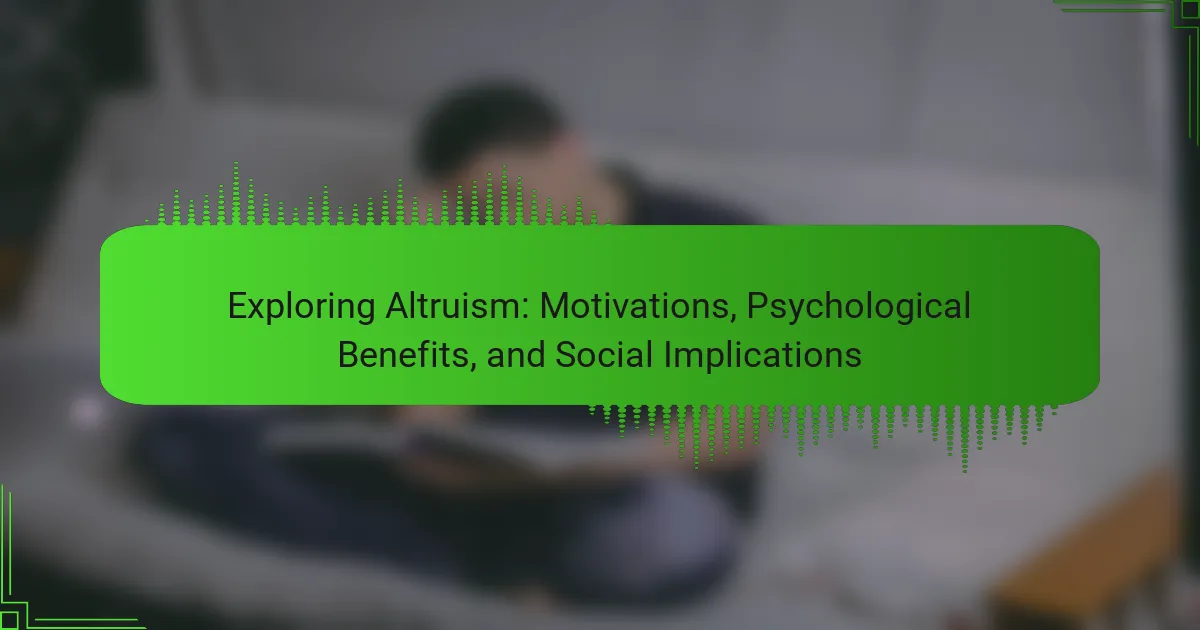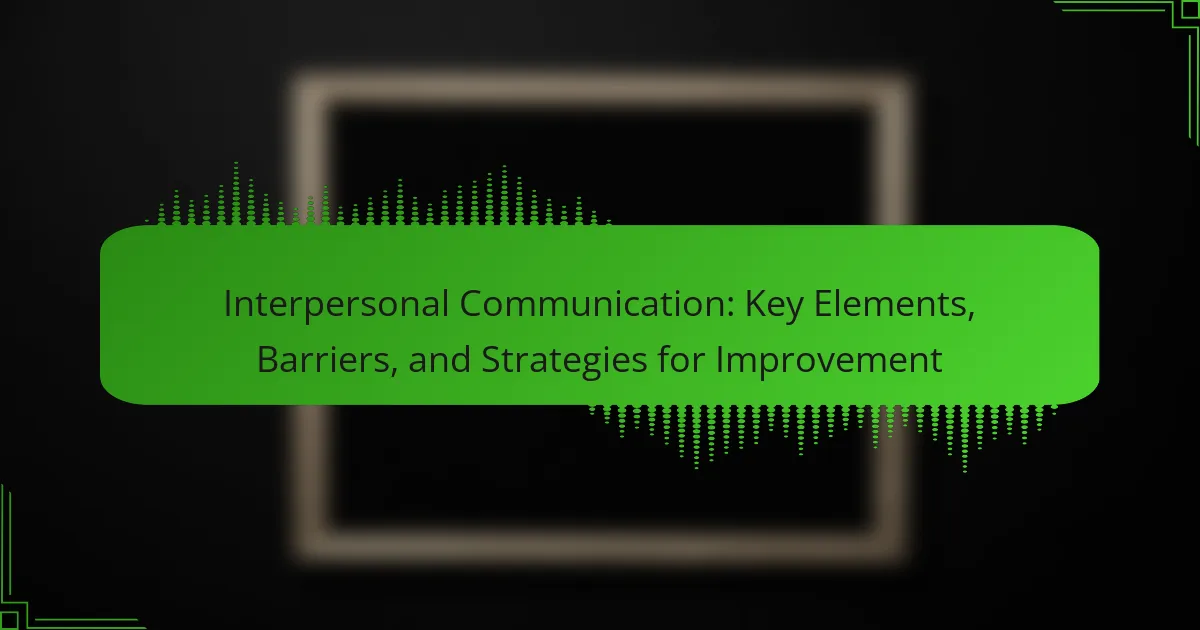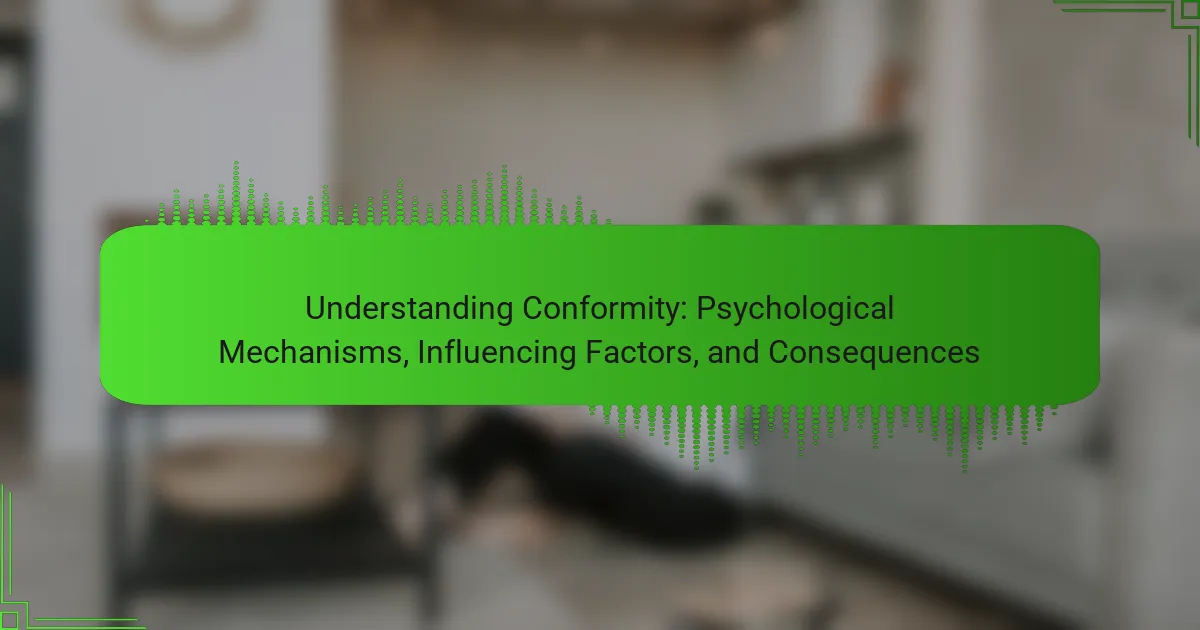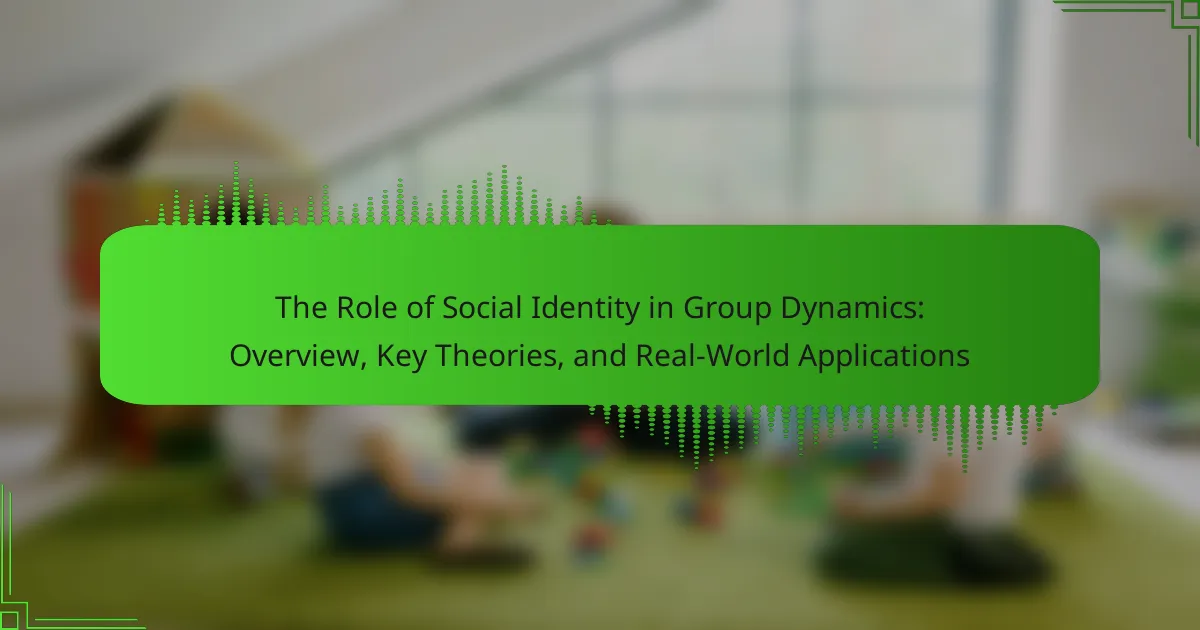Altruism is defined as the selfless concern for the well-being of others, characterized by actions that benefit others without expectation of reward. This article explores the motivations behind altruistic behavior, highlighting its psychological benefits, such as increased happiness and life satisfaction, as well as its social implications, including enhanced community cohesion and trust. Research indicates that altruistic actions activate brain regions linked to pleasure, suggesting a positive feedback loop that encourages further acts of kindness. The article also discusses practical ways to cultivate altruism, such as volunteering, practicing gratitude, and fostering empathy, ultimately contributing to a more supportive and resilient society.
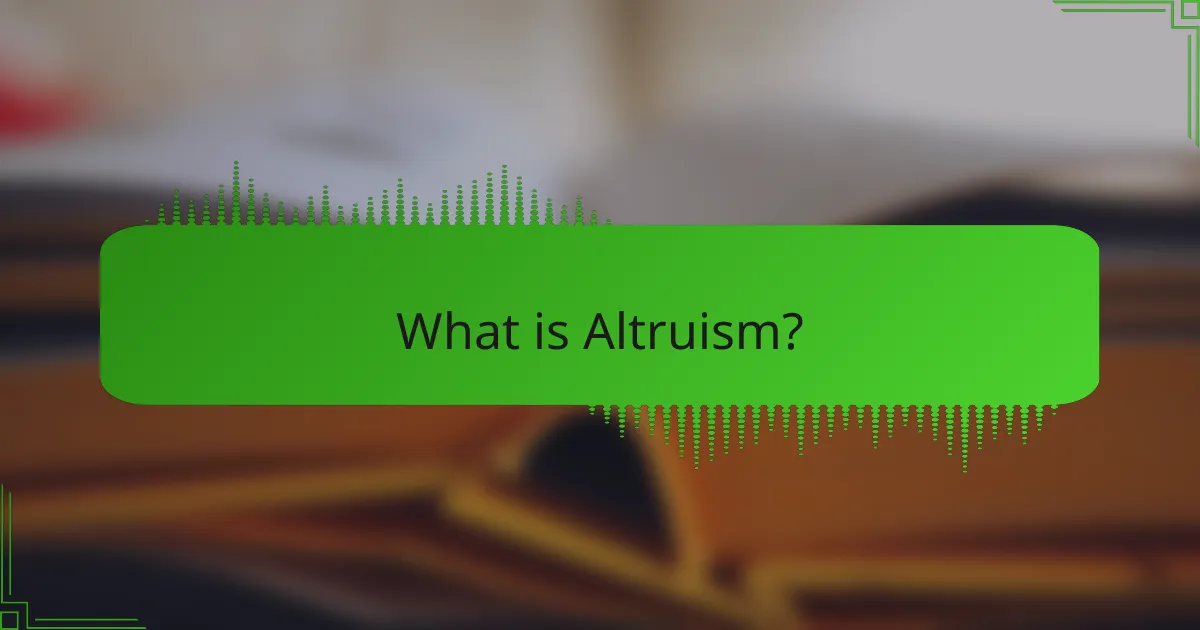
What is Altruism?
Altruism is the selfless concern for the well-being of others. It involves acting to benefit someone else without expecting anything in return. Altruistic behavior can be seen in various forms, such as volunteering, donating to charity, or helping those in need. Research indicates that altruism can lead to psychological benefits for the giver, including increased happiness and life satisfaction. Studies show that altruistic actions activate brain regions associated with reward and pleasure. These findings suggest that helping others can create a positive feedback loop, encouraging further altruistic behavior.
How is altruism defined in psychological terms?
Altruism in psychological terms is defined as selfless concern for the well-being of others. It involves acting to benefit someone else without expecting any personal gain. This behavior is often motivated by empathy and compassion. Research shows that altruistic actions can enhance social bonds and contribute to overall societal well-being. Studies indicate that engaging in altruistic behavior can also lead to psychological benefits for the giver, such as increased happiness and life satisfaction. The psychological perspective emphasizes the intrinsic rewards of helping others, reinforcing the notion that altruism is a fundamental aspect of human behavior.
What are the key characteristics of altruistic behavior?
Altruistic behavior is characterized by selflessness and a genuine concern for the well-being of others. Individuals exhibiting altruism often prioritize the needs of others over their own interests. This behavior can manifest through acts of kindness, generosity, and support. Altruistic actions are typically motivated by empathy and compassion. Research indicates that altruism can enhance social bonds and promote community cohesion. Studies show that altruistic behavior can lead to psychological benefits, such as increased happiness and life satisfaction. For instance, a study published in the Journal of Happiness Studies found that individuals who engage in helping behaviors report higher levels of personal well-being.
How does altruism differ from related concepts like empathy and compassion?
Altruism is the selfless concern for the well-being of others. It differs from empathy, which is the ability to understand and share the feelings of another person. While empathy involves emotional resonance, altruism emphasizes action for the benefit of others without expecting anything in return.
Compassion is closely related but distinct from altruism. Compassion involves feelings of sympathy and concern for others, often leading to a desire to help. However, altruism specifically denotes actions taken to improve another’s situation, regardless of personal feelings.
Research shows that altruistic behavior can improve social bonds and overall well-being, supporting the idea that altruism is a proactive approach to helping others.
Why do people engage in altruistic acts?
People engage in altruistic acts primarily due to empathy and social connection. Empathy drives individuals to feel compassion for others in need. This emotional response often compels people to take action. Additionally, social connection fosters a sense of belonging and community. Engaging in altruism can enhance personal well-being and life satisfaction. Research indicates that altruistic behavior can activate brain regions associated with pleasure. A study published in “Science” by Moll et al. (2006) found that altruistic acts stimulate the brain’s reward system. This suggests that helping others may provide intrinsic rewards. Overall, the motivations for altruism are deeply rooted in psychological and social factors.
What intrinsic motivations drive individuals towards altruism?
Intrinsic motivations that drive individuals towards altruism include empathy, moral principles, and personal fulfillment. Empathy enables individuals to connect emotionally with others’ suffering. This emotional connection often compels people to act in ways that alleviate that suffering. Moral principles guide individuals to believe in the importance of helping others. These principles are often rooted in cultural or religious beliefs. Personal fulfillment arises from the positive feelings associated with helping others. Studies show that engaging in altruistic behavior can enhance overall well-being. Research indicates that altruism can lead to increased happiness and life satisfaction. Thus, these intrinsic motivations create a strong foundation for altruistic behavior.
How do external factors influence altruistic behavior?
External factors significantly influence altruistic behavior. Social norms, for instance, shape individuals’ perceptions of what is considered acceptable or expected behavior. When people observe others engaging in altruistic acts, they are more likely to mimic these behaviors. Environmental cues, such as the presence of needy individuals, can trigger empathetic responses that lead to altruism. Research shows that individuals are more likely to help when they feel a sense of community or belonging. Additionally, cultural values play a crucial role; societies that prioritize collectivism often see higher rates of altruistic behavior. Economic conditions can also affect altruism; during times of prosperity, people may be more willing to give. Conversely, in times of economic hardship, altruistic actions may decline as individuals prioritize their own needs.
What are the psychological benefits of practicing altruism?
Practicing altruism offers significant psychological benefits. Altruism enhances overall well-being and life satisfaction. Engaging in selfless acts reduces feelings of depression and anxiety. Studies show that helping others triggers the brain’s reward system. This leads to increased feelings of happiness and fulfillment. Research from the University of California found that altruistic behavior boosts mental health. Participants reported greater emotional resilience and lower stress levels. Altruism fosters social connections, contributing to a sense of belonging. Stronger relationships enhance emotional support and improve mental health outcomes.
How does altruism impact mental health and well-being?
Altruism positively impacts mental health and well-being. Engaging in altruistic behaviors can lead to increased happiness and life satisfaction. Studies show that helping others releases endorphins, creating a “helper’s high.” This release of endorphins can reduce stress and enhance mood. Furthermore, altruism fosters social connections, which are crucial for emotional support. Strong social ties are linked to lower rates of depression and anxiety. Research by Post (2005) indicates that altruistic acts can improve self-esteem. Overall, altruism contributes to a more fulfilling and balanced life.
What role does altruism play in fostering happiness and life satisfaction?
Altruism significantly enhances happiness and life satisfaction. Engaging in altruistic acts can lead to increased feelings of joy and fulfillment. Research shows that helping others triggers the release of endorphins, known as the “helper’s high.” A study published in the Journal of Happiness Studies found that individuals who regularly volunteer report higher levels of life satisfaction. Moreover, altruism fosters social connections, which are crucial for emotional well-being. Strong social ties contribute to a sense of belonging and support, further enhancing happiness. Additionally, altruistic behavior can create a positive feedback loop, where happiness encourages more helping behavior. Overall, altruism plays a vital role in promoting both individual and communal well-being.
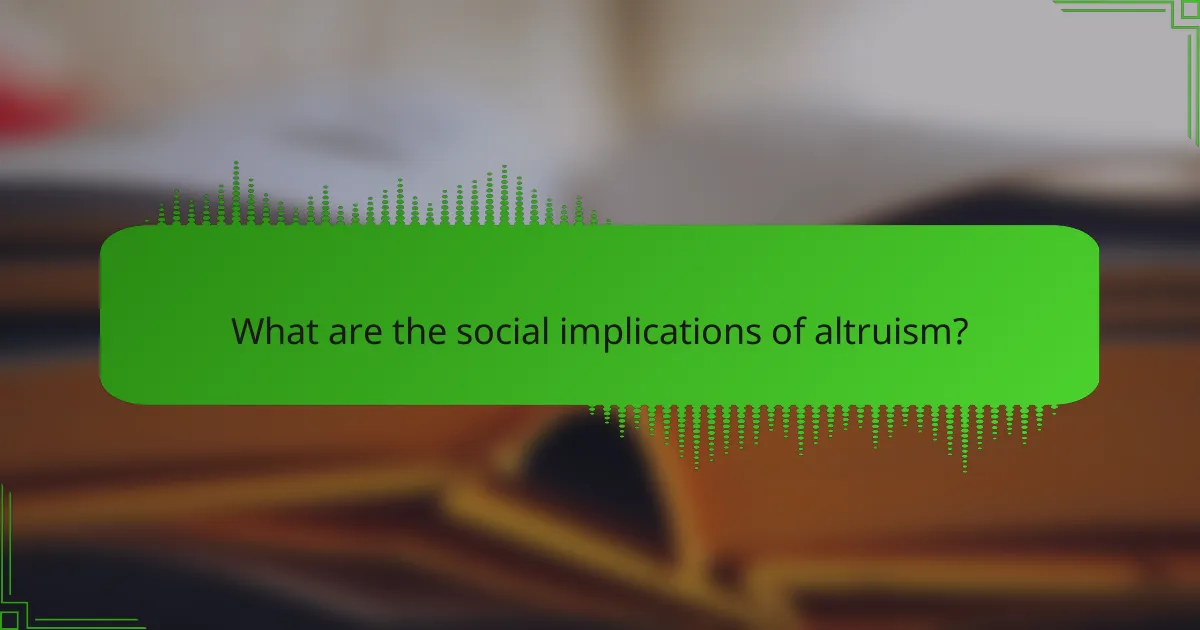
What are the social implications of altruism?
Altruism has significant social implications. It fosters community cohesion and strengthens social bonds. Individuals who engage in altruistic behavior often inspire others to act similarly. This creates a culture of helping and support within communities. Research indicates that societies with higher levels of altruism experience lower crime rates. Altruism can also lead to increased trust among community members. Studies show that altruistic actions can enhance overall well-being in populations. Such behaviors contribute to a more resilient and cooperative society.
How does altruism affect community dynamics?
Altruism positively affects community dynamics by fostering cooperation and social cohesion. When individuals engage in altruistic behaviors, they strengthen interpersonal relationships. This leads to increased trust among community members. Research shows that communities with higher levels of altruism experience lower crime rates. Altruistic actions promote a sense of belonging and shared identity. Furthermore, altruism can enhance collective problem-solving abilities. Studies indicate that altruistic communities are more resilient in facing challenges. Overall, altruism plays a crucial role in enhancing the social fabric of communities.
What are the positive outcomes of altruism in social groups?
Altruism in social groups leads to increased cohesion and trust among members. This behavior fosters a supportive environment where individuals feel valued. Enhanced cooperation is another positive outcome. Groups with altruistic members often achieve shared goals more effectively. Research shows that altruistic actions can improve overall group morale. Higher morale contributes to reduced conflict and increased satisfaction. Additionally, altruism can promote a sense of belonging. This sense of belonging strengthens group identity and commitment. Studies indicate that altruistic behaviors correlate with improved mental well-being for both givers and receivers.
How can altruism contribute to social cohesion and trust?
Altruism can significantly enhance social cohesion and trust within communities. When individuals engage in altruistic behaviors, they foster a sense of belonging among members. This shared experience of helping others strengthens interpersonal relationships. Research indicates that communities with higher levels of altruism report increased trust among residents. For example, a study by the University of California found that neighborhoods with active volunteer groups exhibit stronger social ties. Altruistic acts create a supportive environment where individuals feel valued and connected. Consequently, this leads to a more cooperative society, as trust facilitates collaboration and mutual assistance. Overall, altruism serves as a foundational element in building cohesive and trusting communities.
What challenges exist in promoting altruism in society?
Promoting altruism in society faces several challenges. One significant challenge is the prevalence of individualism. Many cultures prioritize personal success over community welfare. This mindset can hinder collective altruistic efforts. Additionally, there is often a lack of awareness about the benefits of altruism. People may not understand how helping others can enhance their own well-being.
Another challenge is the perception of altruism as a weakness. Some individuals may view selflessness as a vulnerability. This perception can deter people from engaging in altruistic behaviors. Furthermore, limited resources can restrict opportunities for altruistic actions. When individuals struggle to meet their own needs, they may be less inclined to help others.
Social and economic inequalities also pose obstacles. In unequal societies, those with fewer resources may feel unable to contribute. Lastly, negative media portrayals can influence public perceptions of altruism. If altruistic acts are underreported or ridiculed, people may be less motivated to engage in such behaviors.
How do cultural differences influence perceptions of altruism?
Cultural differences significantly influence perceptions of altruism. Different cultures have varying values and norms that shape how altruistic behaviors are viewed. For example, collectivist cultures often emphasize community and group welfare. In these societies, altruism is seen as a duty to support others. Conversely, individualistic cultures prioritize personal achievement and autonomy. Here, altruism may be perceived as a personal choice rather than an obligation. Research by Miller et al. (1990) demonstrated that Americans and Indians view altruistic acts differently based on cultural context. Americans tend to focus on individual intentions, while Indians emphasize the impact on the community. This highlights how cultural backgrounds can frame the understanding and appreciation of altruistic actions.
What barriers prevent individuals from engaging in altruistic behavior?
Barriers that prevent individuals from engaging in altruistic behavior include lack of time, fear of negative consequences, and perceived ineffectiveness. Many individuals feel they do not have enough time to help others due to their own commitments. Fear of negative consequences, such as social backlash or personal risk, also deters altruistic actions. Additionally, when individuals believe their efforts will not make a significant impact, they may choose not to act. Research indicates that these factors can significantly reduce the likelihood of altruistic behavior in various contexts.
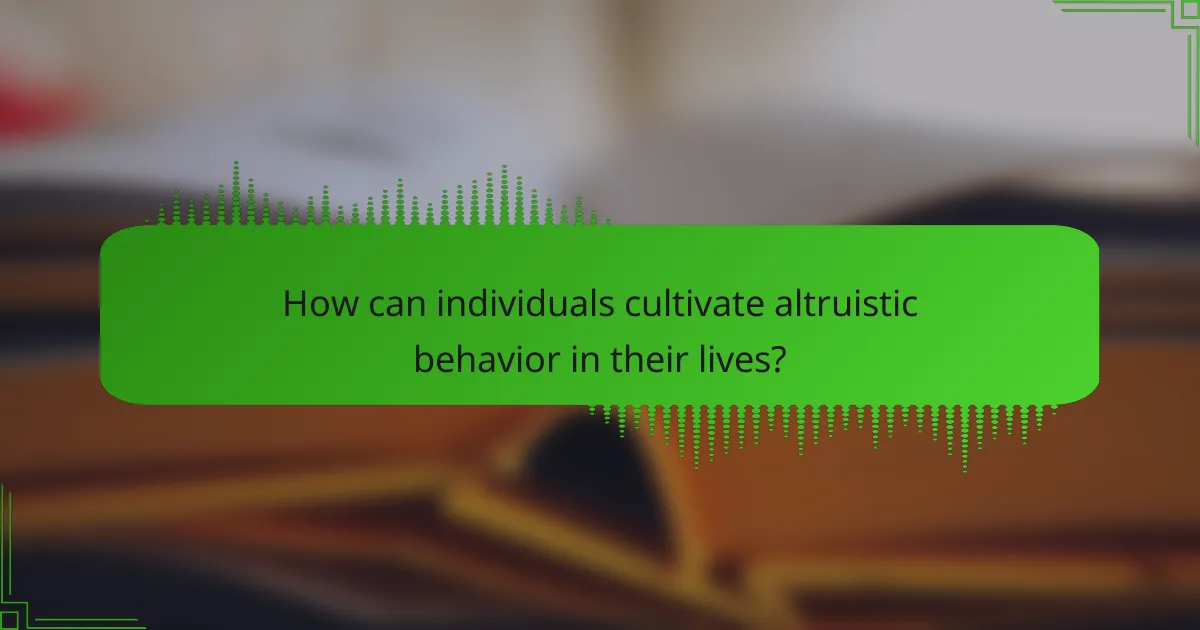
How can individuals cultivate altruistic behavior in their lives?
Individuals can cultivate altruistic behavior by engaging in acts of kindness and empathy. They can start by volunteering in their communities. Studies show that volunteering increases life satisfaction and social connections. Practicing gratitude can also enhance altruistic tendencies. Keeping a gratitude journal has been linked to increased prosocial behavior. Additionally, individuals can educate themselves about social issues. Understanding the challenges faced by others fosters empathy and motivates action. Forming connections with diverse groups encourages compassion and altruism. Research indicates that shared experiences can strengthen altruistic behavior. Overall, consistent practice of these actions can lead to a more altruistic mindset.
What practical steps can one take to become more altruistic?
Engaging in altruistic behavior can be achieved through several practical steps. First, volunteering time for community service can foster a sense of connection and empathy. Studies show that volunteering enhances well-being and promotes prosocial behavior. Second, practicing active listening can improve understanding and compassion towards others. Research indicates that empathy can be cultivated through such interactions. Third, setting aside resources for charitable donations can directly impact those in need. Statistics reveal that financial contributions can significantly support various causes. Fourth, educating oneself about social issues can inspire action and awareness. Knowledge about challenges faced by others can motivate altruistic behavior. Finally, surrounding oneself with altruistic individuals can create a supportive environment that encourages helping behavior. Evidence suggests that social influence plays a crucial role in promoting altruism.
How can volunteering enhance one’s sense of altruism?
Volunteering enhances one’s sense of altruism by fostering a connection to community needs. Engaging in volunteer work allows individuals to witness the impact of their efforts firsthand. This experience can deepen empathy for others and strengthen the desire to help. Research indicates that volunteering increases feelings of social connectedness and purpose. A study published in the Journal of Happiness Studies found that volunteers report higher levels of life satisfaction. Furthermore, consistent engagement in altruistic activities reinforces a positive self-identity associated with helping others. As a result, individuals may feel more compelled to continue altruistic behaviors in the future.
What role do mindfulness and gratitude play in fostering altruistic tendencies?
Mindfulness and gratitude significantly enhance altruistic tendencies. Mindfulness promotes awareness of the present moment and fosters empathy towards others. This increased empathy encourages individuals to engage in prosocial behaviors. Gratitude, on the other hand, cultivates a sense of appreciation for others’ contributions. Research indicates that practicing gratitude can lead to increased feelings of connectedness. A study by Emmons and McCullough (2003) found that individuals who regularly express gratitude are more likely to help others. Together, mindfulness and gratitude create a mindset conducive to altruism.
What are some common misconceptions about altruism?
Common misconceptions about altruism include the belief that it is purely selfless. Many people think altruistic acts do not benefit the giver. However, research shows that helping others often leads to psychological benefits for the helper. Another misconception is that altruism is rare. Studies indicate that most people engage in altruistic behavior at some point in their lives. Additionally, some believe altruism is motivated solely by moral obligation. In reality, emotions like empathy and compassion play significant roles in altruistic actions. Lastly, there is a notion that altruism is primarily linked to financial donations. Altruism can also manifest through time, effort, and emotional support.
How do myths about altruism affect individual participation in altruistic acts?
Myths about altruism can significantly hinder individual participation in altruistic acts. These myths often suggest that altruism is purely selfless or that only certain types of people can be altruistic. Such beliefs can create feelings of inadequacy among individuals who may wish to engage in altruistic behavior but feel they do not meet these perceived standards.
Research indicates that when individuals believe altruism requires extraordinary self-sacrifice, they may feel discouraged from participating. For example, a study by Batson et al. (2002) found that individuals who viewed altruism as requiring extreme selflessness were less likely to engage in helping behaviors.
Additionally, myths can lead to the misconception that altruism is not beneficial for the giver. This perception can deter individuals from helping others, as they may underestimate the psychological benefits of altruistic actions. Overall, these myths create barriers to participation by fostering negative beliefs about the nature and impact of altruism.
What is the difference between true altruism and self-serving behavior?
True altruism involves selflessly helping others without expecting any personal gain. It is characterized by genuine concern for the well-being of others. In contrast, self-serving behavior is motivated by personal benefit, even if it appears altruistic. This behavior often seeks recognition, rewards, or enhanced social status. Research shows that true altruism can lead to increased happiness and fulfillment. Studies indicate that self-serving actions may provide short-term satisfaction but do not foster lasting contentment. The distinction lies in the intent behind the actions and the outcomes they produce for the individual.
What resources are available for those interested in exploring altruism further?
Books on altruism include “The Altruism Equation” by Lee Alan Dugatkin. This book explores the biological basis of altruistic behavior. Research articles, such as “The Psychology of Altruism” published in the Journal of Personality and Social Psychology, provide empirical evidence on altruistic motivations. Online platforms like Coursera offer courses on altruism and related psychological concepts. Non-profit organizations, such as the Greater Good Science Center, provide research and resources on the benefits of altruism. Additionally, TED Talks on altruism present personal stories and insights from experts in the field. These resources collectively enhance understanding of altruism and its implications.
Which books and articles provide valuable insights into altruistic behavior?
Books and articles that provide valuable insights into altruistic behavior include “The Altruism Equation” by Lee Alan Dugatkin. This book explores the evolutionary basis of altruism. Another significant work is “Altruism: A History” by Thomas J. McCarthy. It examines the historical context of altruistic behavior. Additionally, the article “The Neuroscience of Altruism” by Jorge Moll and others offers insights into the brain’s role in altruistic actions. The research titled “The Nature of Altruism” published in the journal “Nature” discusses the psychological underpinnings of altruism. These sources collectively enhance understanding of altruistic behavior from various perspectives.
What organizations promote altruism and how can one get involved?
Organizations that promote altruism include the Red Cross, Habitat for Humanity, and United Way. The Red Cross provides emergency assistance and disaster relief. Habitat for Humanity builds homes for those in need. United Way focuses on improving community conditions through various programs.
To get involved, individuals can volunteer their time or donate resources. Many organizations offer training for volunteers. They also provide opportunities for fundraising and awareness campaigns. Engaging in community service projects is another way to contribute.
Research shows that volunteering enhances personal well-being and community cohesion. According to a study by the Corporation for National and Community Service, volunteers are 27% more likely to find a job after being out of work. This highlights the mutual benefits of altruism for both the giver and receiver.
Altruism is defined as the selfless concern for the well-being of others, characterized by actions that benefit others without expecting personal gain. This article explores the motivations behind altruistic behavior, including empathy and social connection, and highlights its psychological benefits, such as increased happiness and life satisfaction. Additionally, it examines the social implications of altruism, including its role in fostering community cohesion and trust, as well as the challenges faced in promoting altruism within society. Finally, practical steps for cultivating altruistic behavior and resources for further exploration of the topic are provided.
